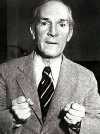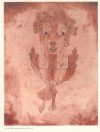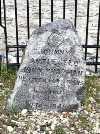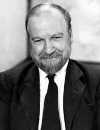 Though she won 67 tournament titles in her career, American tennis player Billie Jean King is perhaps best known for the “Battle of the Sexes” against former champion Bobby Riggs. In 1973, Riggs emerged from retirement and defeated Margaret Court in a nationally televised match. Proclaiming the superiority of the male athlete over the female no matter what the age, he challenged Billie Jean King, who accepted and routed him in three straight sets. How many people reportedly watched the match? Discuss
Though she won 67 tournament titles in her career, American tennis player Billie Jean King is perhaps best known for the “Battle of the Sexes” against former champion Bobby Riggs. In 1973, Riggs emerged from retirement and defeated Margaret Court in a nationally televised match. Proclaiming the superiority of the male athlete over the female no matter what the age, he challenged Billie Jean King, who accepted and routed him in three straight sets. How many people reportedly watched the match? Discuss
Source: The Free Dictionary
 Each of the autonomous regions of
Each of the autonomous regions of  Sinclair was a prolific American novelist and socialist activist who wrote over 90 books, including The Jungle, a best-selling muckraking exposé of conditions in the Chicago meat-packing industry that aroused public indignation and resulted in the passage of food inspection laws in the US. He also organized a socialist reform movement in the 1930s and won the Democratic nomination for governor of California but was defeated in 1934. For what book was Sinclair awarded the Pulitzer Prize?
Sinclair was a prolific American novelist and socialist activist who wrote over 90 books, including The Jungle, a best-selling muckraking exposé of conditions in the Chicago meat-packing industry that aroused public indignation and resulted in the passage of food inspection laws in the US. He also organized a socialist reform movement in the 1930s and won the Democratic nomination for governor of California but was defeated in 1934. For what book was Sinclair awarded the Pulitzer Prize?  Paul Klee was a Swiss painter, graphic artist, art theorist, and violinist. His early introduction to music played a large role in the way he approached his art and its imagery. Klee often varied the media and style in which he worked and produced over 10,000 works before his death. He also taught at the Bauhaus school of art and architecture with his friend and fellow artist Wassily Kandinsky. During WWI, Klee served in the German army; what was his job?
Paul Klee was a Swiss painter, graphic artist, art theorist, and violinist. His early introduction to music played a large role in the way he approached his art and its imagery. Klee often varied the media and style in which he worked and produced over 10,000 works before his death. He also taught at the Bauhaus school of art and architecture with his friend and fellow artist Wassily Kandinsky. During WWI, Klee served in the German army; what was his job?  Martha Corey was a Massachusetts woman hanged for the crime of witchcraft during the Salem witch trials. A pious churchgoer, she had refused to confess but was convicted anyway. Her husband, Giles Corey, was also eventually accused but refused to enter a plea at his trial. In an attempt to make him enter a plea, he was pressed beneath an increasingly heavy load of stones. He died two days before his wife’s execution. What did Giles reportedly reply each time he was asked for his plea?
Martha Corey was a Massachusetts woman hanged for the crime of witchcraft during the Salem witch trials. A pious churchgoer, she had refused to confess but was convicted anyway. Her husband, Giles Corey, was also eventually accused but refused to enter a plea at his trial. In an attempt to make him enter a plea, he was pressed beneath an increasingly heavy load of stones. He died two days before his wife’s execution. What did Giles reportedly reply each time he was asked for his plea?  A legend in his own time, John Chapman—better known as “
A legend in his own time, John Chapman—better known as “ Praised for his highly imaginative and original writings, Golding was a British author whose works focus on the eternal nature of man. He won the Nobel Prize in Literature in 1983 and was knighted in 1988. In his best-known work, the allegorical Lord of the Flies, he described the nightmarish adventures of a group of English schoolboys stranded on an island and traced their degeneration from a state of innocence to blood lust and savagery. What else did he write?
Praised for his highly imaginative and original writings, Golding was a British author whose works focus on the eternal nature of man. He won the Nobel Prize in Literature in 1983 and was knighted in 1988. In his best-known work, the allegorical Lord of the Flies, he described the nightmarish adventures of a group of English schoolboys stranded on an island and traced their degeneration from a state of innocence to blood lust and savagery. What else did he write?  The Death of Marat, painted by Jacques-Louis David, depicts the 1793 assassination of radical journalist and revolutionary activist Jean-Paul Marat and is one of the most famous images of the French Revolution. Marat was stabbed while writing in his bathtub, and his murderer’s name is written on the paper he holds in the painting. David’s representation of this scene is reminiscent of depictions of Christian martyrs in religious works. What is the political significance of this imagery?
The Death of Marat, painted by Jacques-Louis David, depicts the 1793 assassination of radical journalist and revolutionary activist Jean-Paul Marat and is one of the most famous images of the French Revolution. Marat was stabbed while writing in his bathtub, and his murderer’s name is written on the paper he holds in the painting. David’s representation of this scene is reminiscent of depictions of Christian martyrs in religious works. What is the political significance of this imagery?